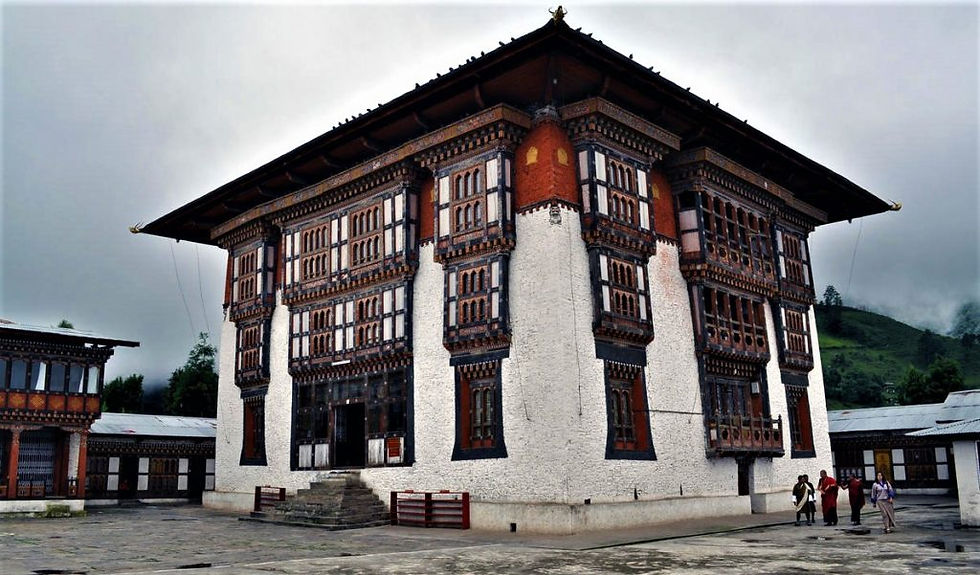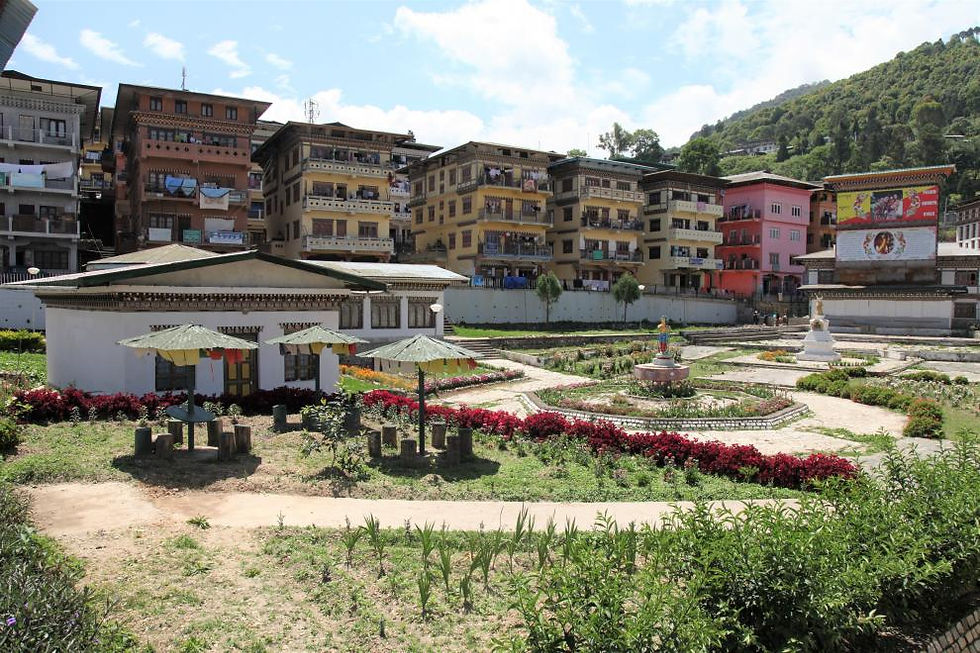Discovering the treasures of Eastern Bhutan: Tour to Mongar
- Saidpiece
- Mar 21, 2023
- 5 min read
Mongar, a picturesque town located in eastern Bhutan, is known for its stunning natural beauty, cultural heritage, and unique experiences. If you're planning a trip to Mongar, here are some things you should consider adding to your itinerary:
Visit Mongar Dzong
The Mongar Dzong is a 17th-century fortress and monastery that serves as the administrative headquarters of the district. Mongar Dzong, also known as Mongar Rabdey, is a historic fortress and monastery located in Mongar, Bhutan. It serves as the administrative headquarters of the Mongar district and is also a center of religious and cultural activity. The dzong's unique architecture, with its three courtyards and imposing towers, is a sight to behold. You can take a guided tour of the dzong to learn more about its history and cultural significance.

The Mongar Dzong is situated on a hill overlooking the town and is surrounded by lush greenery and beautiful scenery. The dzong's unique architecture is a blend of traditional Bhutanese and modern styles, with three courtyards and imposing towers. The dzong also features a beautiful temple and a prayer hall, both of which are decorated with intricate carvings and colorful murals.
The dzong is open to visitors and offers guided tours that provide insight into its history and cultural significance. Visitors can also observe the daily activities of the monks who live and study at the dzong. The dzong is also home to several important festivals throughout the year, including the Mongar Tshechu, which is held in the 8th Bhutanese lunar month (usually in November).
The Mongar Dzong is a significant cultural and historical landmark in Bhutan and is a testament to the country's rich heritage and traditions. It is a must-visit destination for anyone interested in Bhutanese culture and history.
Hike to Dramedtse Monastery
Dramedtse Lhakhang, constructed in the 16th century by Ani Cheten Zangmo, the grand-daughter of the revered Terton Pema Lingpa, is one of the most notable religious sites in the region, and was built with the intention of spreading Nyingmapa teachings in the eastern area. It is among the most popular monasteries in the region, with visitors mainly coming from Dramedtse and surrounding districts, particularly during the annual festival. The famous "Drametse Ngacham," or "Dance of the Drums of Drametse," was born here in the 16th century, and it is now a popular dance performed at major festivals.

This dance, which is considered the best-known of all Bhutanese dances, was created in the 16th century at Drametse Monastery in eastern Bhutan by a saint who had a vision of Guru Rinpoche's paradise. Twelve men wearing yellow skirts and animal masks perform the dance while playing drums; they represent Guru Rinpoche's entourage and celebrate the triumph of religion. It is believed that this dance brings liberation to those who witness it.
Although the road to reach the monastery from the Mongar-Trashigang highway is narrow and scattered with pebbles, it takes approximately 1.5 hours to get there. Each bend on the uphill climb offers a beautiful view of valleys and distant mountains. You may also catch a glimpse of Udzorong village in the Trashigang Dzongkhag.
UNESCO designated this dance as a "Masterpiece of the World Intangible Heritage" in 2005. The Mask Dance of the Drums of Drametse was choreographed in the monastery in the 16th century, after the founder Kunga Gyeltshen, the great grandson of Terton Pema Lingpa, had a vision of Guru Rinpoche's Zangtopelri (Copper-Colored Mountain Paradise). A total of 16 male dancers wearing masks and 10 musicians perform the dance. They first perform a prayer dance in the main shrine, and then, one by one, they enter the monastery's courtyard. The dance is divided into two sections: a quiet, meditative portion that represents the peaceful deities, and a fast, athletic portion that represents the wrathful ones. The quintessence of Bhutanese identity, this dance has been performed for nearly five centuries all over the country and has now become an essential component of Tshechu in Bhutan. UNESCO designated Drametse Ngacham as a "Masterpiece of the Intangible Heritage" during the Third Proclamation of Masterpieces of the Oral and Intangible Heritage of Humanity in Paris in November 2005, due to its worldly, spiritual, and artistic values.
If you're up for a bit of a challenge, consider hiking to the Drametse Monastery. The monastery is perched on a hilltop overlooking the town and offers breathtaking views of the surrounding mountains. The hike takes about 2-3 hours, and the trail is well-maintained.
Attend Mongar Tshechu
Bhutan is known for its vibrant festivals, and Mongar is no exception. The Mongar Tshechu is a colorful festival that takes place in the dzong courtyard and features traditional music, dance, and costumes.

Annually, for three days, Mongar Dzong hosts a Tshechu festival in its courtyard, drawing devotees from nearby districts who come to witness the masked dances, accompanied by cultural performances that entertain the spectators. In Bhutan, masked dances hold significant religious and cultural value, and attendees believe that witnessing these sacred performances liberates them. The festival attracts people dressed in their finest attire, and they often bring packed lunches to enjoy while watching the performances. The majority of dances featured at the festival are unique to the region.
Go birdwatching
Mongar, Bhutan is a haven for birdwatchers with its diverse range of bird species. The region's rich biodiversity and unspoiled natural beauty provide a perfect habitat for many endemic and migratory bird species.

To go birdwatching in Mongar, you can explore the forests and wetlands near the town, which are home to a variety of birds, including the endangered white-bellied heron. Some popular birdwatching spots in Mongar include the Yadi and Narang trails, which offer opportunities to see species such as the chestnut-breasted partridge, Ward's trogon, and the yellow-rumped honeyguide.
Another popular bird watching destination is the Kori La Pass, located about 20 kilometers from Mongar. The pass provides stunning views of the surrounding mountains and valleys and is home to species such as the rufous-necked hornbill, white-browed bush robin, and the dark-sided thrush.
Trek to Aja Ney
Aja Ney is a sacred pilgrimage site located in the hills above Mongar, Bhutan. The site is believed to be the spot where Guru Rinpoche, a great Buddhist saint, meditated and left his footprints in the rock. It is considered a place of great spiritual power, and many devotees visit the site to pray and seek blessings.

To reach Aja Ney, one has to take a short but steep hike of about an hour from the nearby village of Duksum. The hike is relatively strenuous, but the stunning views of the surrounding mountains and valleys make it a worthwhile experience. The trail winds through lush forests, past small waterfalls, and across several suspension bridges over the Kuri Chhu river.
Upon reaching Aja Ney, visitors are greeted by the sight of a large rock with the imprint of Guru Rinpoche's foot. The rock is surrounded by prayer flags and small shrines, and many devotees offer prayers and make offerings at the site. The area around Aja Ney is also home to several other sacred sites, including a cave where Guru Rinpoche is said to have meditated.

Mongar presents an unparalleled mix of scenic splendor, cultural legacy, and conventional encounters. Whether you want to discover ancient dzongs, trek to isolated monasteries, or relish a relaxing hot stone bath, the town has something for all kinds of travelers. So, don't wait any longer, prepare yourself for a trip to Mongar, and explore the obscure treasures of eastern Bhutan.








Comments